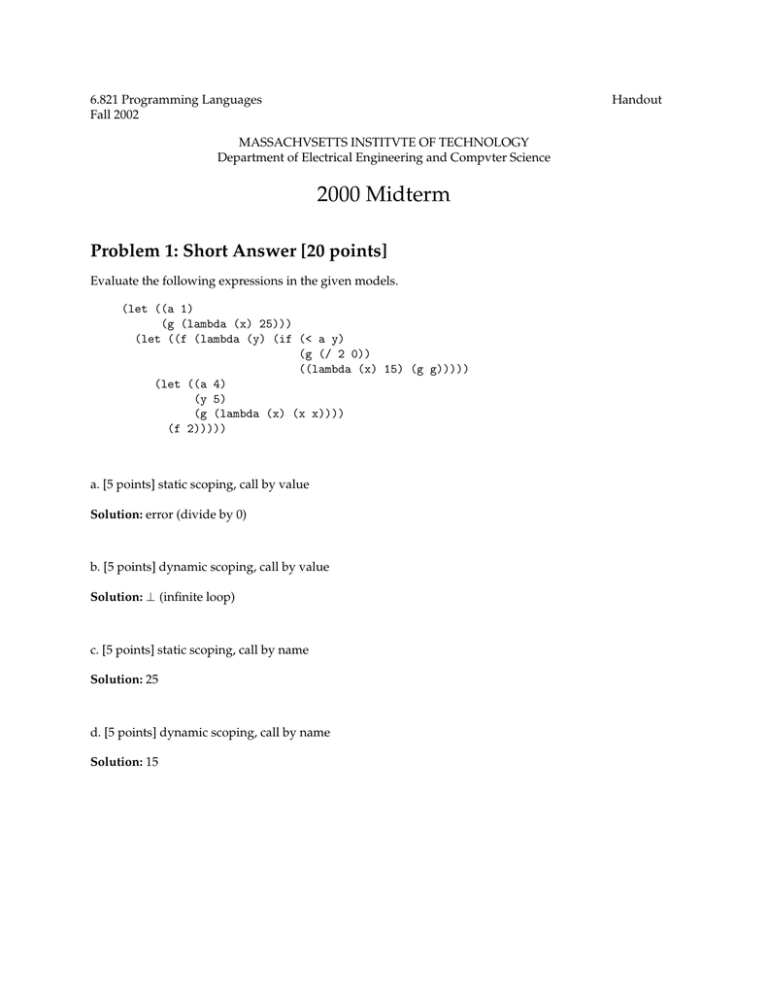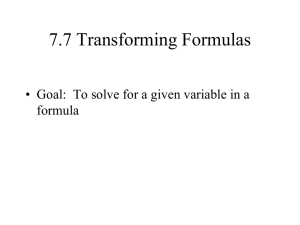6.821 Programming Languages Handout Fall 2002 MASSACHVSETTS INSTITVTE OF TECHNOLOGY
advertisement

6.821 Programming Languages
Fall 2002
Handout
MASSACHVSETTS INSTITVTE OF TECHNOLOGY
Department of Electrical Engineering and Compvter Science
2000 Midterm
Problem 1: Short Answer [20 points]
Evaluate the following expressions in the given models.
(let ((a 1)
(g (lambda (x) 25)))
(let ((f (lambda (y) (if (< a y)
(g (/ 2 0))
((lambda (x) 15) (g g)))))
(let ((a 4)
(y 5)
(g (lambda (x) (x x))))
(f 2)))))
a. [5 points] static scoping, call by value
Solution: error (divide by 0)
b. [5 points] dynamic scoping, call by value
Solution: ⊥ (infinite loop)
c. [5 points] static scoping, call by name
Solution: 25
d. [5 points] dynamic scoping, call by name
Solution: 15
Problem 2: Operational Semantics: Postfix + {sdup} [20 points]
Alyssa P. Hacker extended the PostFix language with a new command called sdup: smart dup. This allows
us to compute square(x) = x2 without hurting the termination property of PostFix programs. The informal
semantics for sdup is as follows: duplicate the top of the stack if it is a number or a command sequence that
doesn’t contain sdup; otherwise, report an error.
Formally, the operational semantics has been extended with the following two transition rules:
�sdup . Qrest , N . S� ⇒ �Qrest , N . N . S�
[sdup-numeral]
�sdup . Qrest , Q . S� ⇒ �Qrest , Q . Q . S�
where ¬(contains sdup Q)
[sdup-sequence]
contains sdup : Command ∗ → Bool is a helper function that takes a sequence of commands and checks
whether it contains sdup or not (yes, contains sdup handles even nested sequences of commands)
As a new graduate student in Alyssa’s AHRG (Advanced Hacking Research Group), you were assigned
to give a proof that all PostFix + {sdup} programs terminate. However, you are not alone! Alyssa already
took care of most of the mathematical weaponry:
Consider the product domain P = Nat × Nat (as usual, Nat is the set of natural numbers, starting with
0). On this domain, we define the relation <P as follows:
Definition 1 (lexicographic order) �a1 , b1 � <P �a2 , b2 � iff:
a. a1 < a2 or
b. a1 = a2 and b1 < b2 .
E.g. �3, 10000� <P �4, 0�, �5, 2� <P �5, 3�.
Definition 2 A strictly decreasing chain in P is a finite or infinite sequence of elements p1 , p2 , . . . such that
pi ∈ P, ∀i and pi+1 <P pi , ∀i.
After a long struggle, Alyssa proved the following lemma for you:
Lemma 1 There is no infinite strictly decreasing chain in P .
Give a rigorous proof that each PostFix+ {sdup} program terminates by using a cleverly defined energy
function ES conf ig . Hint: Each transition of Postfix reduces the energy function E config you saw in class. Try
to see what is reduced by the two new rules, and how you can combine these two things into a single energy
function.
Note: If you need to use some helper functions that are intuitively easy to describe but tedious to define
(e.g. contains sdup), just give an informal description of them.
Grading scheme:
• [10 points] ES conf ig ;
• [10 points] Termination proof.
Solution:
Consider the following energy function:
ES conf ig : C → Nat × Nat = λ�Q, S� . �sdup count [[�Q, S�]], E config [[�Q, S�]]�
where sdup count is a helper function that computes the number of times sdup appears in a configuration
and E config is the energy function shown in class.
Let’s first prove that for any transition cold ⇒ cnew , ES conf ig [[cnew ]] <P ES conf ig [[cold ]].
2
Old transitions: None of them introduces new sdup commands but they all strictly decrease E config . So, the
first component of ES conf ig doesn’t increase and the second one strictly decreases which implies
ES conf ig [[cnew ]] <P ES conf ig [[cold ]].
New transitions: Each of the new sdup related rules “consumes” exactly one sdup: this is clearly true for
[dup-numeral] and [dup-sequence] doesn’t duplicate sequences containing sdup. So the first component of
ES conf ig is strictly decreased by these transitions which implies that no matter what happens with the sec­
ond component (note that [dup-sequence] might actually increase it), ES conf ig [[cnew ]] <P ES conf ig [[cold ]] for
the new transitions too.
Suppose now for the sake of contradiction that there is some PostFix + {sdup} program with an infinite
execution c1 ⇒ c2 ⇒ c3 ⇒ . . . . This implies ES conf ig [[c2 ]] <P ES conf ig [[c1 ]], ES conf ig [[c3 ]] <P ES conf ig [[c2 ]], . . .
and we’ve just constructed an infinite strictly decreasing chain in P! Contradiction with Lemma 1.
3
Problem 3: State: FLK! + {undo-once!} [30 points]
Ben Bitdiddle introduced a new undo-once! instruction to roll the store back one operation at a time. Informally speaking, undo-once! undoes the last store operation (cell or cell-set!). If there is no store
operation to undo, undo-once! does nothing.
E
::=
|
...
(undo-once!)
[Classic FLK! expressions]
[Undo last store operation]
Initially, Ben thought of modifying the meaning function to use a stack of stores (as it did in the fall-98
midterm), but the implementors refused to work on such an idea and threatened to quite Ben’s company en
masse. So, Ben had to turn to a more efficient idea: maintain the current store and a stack of undo functions.
An undo function takes a store and reverses a specific store operation (one done with cell or cell-set!)
to obtain the store before the operation.
Pursuing this idea, Ben modified the Cmdcont semantic domain and the top level function as follows:
Cmdcont = Store → StoreTransformStack → Expressible
h ∈ StoreTransformStack = StoreTransform∗
t ∈ StoreTransform = Store → Store
T L[[E ]] = ( E [[E ]] empty-env top-level-cont empty-store [ ]StoreTransform )
As each store operation (cell or cell-set!) consists of assigning a Storable to a Location, it can be
reversed by putting the old Assignment into that Location. Ben even wrote the following undo function
producer for you:
make-undofun : Location → Assignment → StoreTransform
= λlα . λs . (assign’ l α s)
assign’ is a function similar to assign which allows us to assign even unassigned:
assign’ : Location → Assignment → Store → Store
= λl1 αs . λl2 . if (same-location? l1 l2 ) then α else (fetch l2 s) fi
If a store operation modified location l, the undo function for it can be obtained by calling make-undofun on
l and the old assignment for l. All the undo functions that you write in this problem must be obtained
by calling make-undofun with the appropriate arguments.
Now, guess what?, Ben went away to deliver a better Internet and grab some more billions, and you
were assigned to finish his job.
a. [10 points] Write the meaning function clause for E [[(undo-once!)]].
Solution:
E [[(undo-once!)]] =
λeksh . matching h
� t . hrest [] (k (Unit �→Value unit) (t s) hrest )
� [ ]StoreTransform [] (k (Unit �→Value unit) s h)
endmatching
We specially treat the case of an enpty stack of undo functions: when there is nothing to undo,
undo-once! does nothing.
b. [10 points] Write a revised version for E [[(primop cell-set! E1 E2 )]].
Solution:
4
E [[(primop cell-set! E1 E2 )]] =
λek . (E [[E1 ]] e (test-location (λl . (E [[E2 ]] e
(λvsh . (k (Unit �→Value unit)
(assign l v s )
(make-undofun l (fetch l s) ) . h )))))))
The store that is passed to k is, as previously, the store obtained by assigning v to location l; we add
to the head of the stack of store transformers an undo function that restores the old assignment for l.
c. [10 points] Write a revised version for E [[(cell E)]]. Note: we want to be able to undo even cell creation
operations. That is, the following program must end with an error:
(let ((c (cell 0)))
(begin
(undo-once!)
(primop cell-ref c)))
Solution:
E [[(cell E)]] =
λek . (E [[E ]] e (λvsh . ((λl . (k (Location �→Value l)
(assign l v s)
(make-undofun l (Unassigned �→Assignment unassigned)) . h ))
(fresh-loc s) ))))
Undoing a cell allocation is done by assigning back unassigned to the cell location l. Now, that cell is
free to be allocated again! Calling (λl . . . .) on (fresh-loc s) is just a trick to avoid us writing (fresh-loc s)
three times (it’s like the desugaring for let in FL).
5
Problem 4: Denotational Semantics: Control [30 points]
Sam Antics of eFLK.com wants to cash in on the election year media bonanza by introducing a new feature
into standard FLK!:
(elect Epres Evp )¨ ;
;
;
;
(reelect)¨ ;
;
;
(impeach)¨ ;
;
;
evaluates to Epres unless impeach
is evaluated within Epres , in which
case evaluates to Evp . If impeach is
evaluated within Evp , signals an error.
if evaluated within Epres of (elect Epres Evp ),
goes back to the beginning of elect.
otherwise, signals an error.
if evaluated within Epres of (elect Epres Evp ),
causes the expression to evaluate to Evp .
otherwise, signals an error.
For example:
(let ((scandals (primop cell 0)))
(elect (if (< (primop cell-ref scandals) 5)
(begin (primop cell-set! (+ (primop cell-ref scandals) 1))
(reelect))
(impeach))
(* (primop cell-ref scandals) 2)))
⇒ 10
You are hired by eFLK.com to modify the standard denotational semantics of FLK! to produce FLK! 2000
Presidential Edition (TM). To get you started, Sam tells you that he has added the following domains:
r ∈ Prescont = Cmdcont
i ∈ Vpcont = Cmdcont
He also changed the signature of the meaning function:
E : Exp → Environment → Prescont → Vpcont → Expcont → Cmdcont
a. [9 points] give the meaning function for (elect Epres Evp ).
Solution:
E [[(elect Epres Evp )]] =
λerik . (fixCmdcont (λr1 . E [[Epres ]] e r1 (λs . E [[Evp ]] e
(error-cont cannot-reelect-vp)
(error-cont cannot-impeach-vp) k) k))
b. [7 points] give the meaning function for (reelect).
Solution:
E [[(reelect)]] = λerik . r
6
c. [7 points] give the meaning function for (impeach).
Solution:
E [[(impeach)]] = λerik . i
d. [7 points] using the meaning functions you defined, show that (elect (reelect) 1) is equivalent to ⊥.
Solution:
E [[(elect (reelect) 1)]] =
λerik . (fixCmdcont (λr1 . E [[(reelect)]] e r1 (λs . E [[1]] e
(error-cont cannot-reelect-vp)
(error-cont cannot-impeach-vp) k) k))
⇒
E [[(elect (reelect) 1)]] =
λerik . (fixCmdcont (λr1 . (λerik . r) e r1 (λs . E [[1]] e
(error-cont cannot-reelect-vp)
(error-cont cannot-impeach-vp) k) k))
⇒
E [[(elect (reelect) 1)]] = λerik . (fixCmdcont (λr1 . r1 ))
⇒
E [[(elect (reelect) 1)]] = ⊥
7




